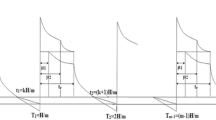Abstract
This paper develops a production-inventory model for a deteriorating item with stock-dependent demand under two storage facilities over a random planning horizon, which is assumed to follow exponential distribution with known parameter. The effects of learning in set-up, production, selling and reduced selling is incorporated. Different inflation rates for various inventory costs and time value of money are also considered. A hybrid genetic algorithm is designed to solve the optimization problem which is hard to solve with existing algorithms due to the complexity of the decision variable. To illustrate the model and to show the effectiveness of the proposed approach a numerical example is provided. A sensitivity analysis of the optimal solution with respect to the parameters of the system is carried out.
Similar content being viewed by others
References
Balkhi ZT (2004) An optimal solution of a general lot size inventory model with deteriorated and imperfect products, taking into account inflation and time value of money. Int J Sys Sci 35(2): 87–96
Bhunia AK, Maiti M (1998) A two warehouse inventory model for deteriorating items with a linear trend in demand and shortages. J Oper Res Soc 49: 287–292
Buzacott JA (1975) Economic order quantities with inflation. Oper Res Q 26(3): 553–558
Chung KH, Kim YH (1989) Economic analysis of inventory systems: a rejoinder. Eng Econ 35: 75–80
Davis L (1991) Handbook of genetic algorithms. Van Nostrand Reinhold, UK
Dey JK, Kar S, Maiti M (2004) An EOQ model with fuzzy lead-time over a finite time horizon under inflation and time value of money. Tamsui Oxford J Manage Sci 20(1): 57–77
Gurnani C (1983) Economic analysis of inventory systems. Int J Product Res 21: 261–277
Hartely RV (1976) Operations research—a managerial emphasis. Goodyear Publishing Company, Cambridge, pp 315–317
Jaber MY, Bonney M (2001) Economic lot sizing with learning and continuous time discounting: is it significant?. Int J Product Econ 71: 135–143
Jaber MY, Goyal SK, Imran M (2008) Economic production quantity model for items with imperfect quality subject to learning effects. Int J Product Econ 115: 143–150
Kar S, Bhunia AK, Maiti M (2001) Inventory of multi-deteriorating items sold from two shops under single management with constraints on space and investment. Comput Oper Res 28: 1203–1221
Misra RB (1979) A note on optimal inventory management under inflation. Naval Res Logist 26(1D): 161–165
Moon I, Yun W (1993) An economic order quantity model with a random planning horizon. Eng Econ 39: 77–86
Moon I, Lee S (2000) The effects of inflation and time-value of money on an economic order quantity model with a random product life cycle. Eur J Oper Res 125: 588–601
Pakhala TPM, Achary KK (1992a) Discrete time inventory model for deteriorating items with two warehouses. Opsearch 29: 90–103
Pakhala TPM, Achary KK (1992b) A deterministic inventory model for deteriorating items with two warehouses and finite replenishment rate. Eur J Oper Res 57: 71–76
Panda S, Saha S, Basu M (2009a) An EOQ model for perishable products with discounted selling price and stock dependent demand. Central Eur J Oper Res 17(1): 31–53
Panda S, Saha S, Basu M (2009b) Optimal production stopping time for perishable products with ramp-type quadratic demand dependent production and setup cost. Central Eur J Oper Res 17(4): 381–396
Ray J, Chaudhuri KS (1997) An EOQ model with stock-dependent demand, shortage, inflation and time discounting. Int J Product Econ 53: 171–180
Roy A, Maiti MK, Kar S, Maiti M (2007) Two storage inventory model with fuzzy deterioration over a random planning horizon. Math Comput Model 46: 1419–1433
Roy A, Maiti MK, Kar S, Maiti M (2009) An inventory model for a deteriorating item with displayed stock dependent demand under fuzzy inflation and time discounting over a random planning horizon. Appl Math Model 33: 744–759
Sarkar BR, Jamal AMM, Wang S (2000) Supply chain models for perishable products under inflation and permissible delay in payment. Comput Oper Res 27: 59–75
Yang HL (2004) Two-warehouse inventory models for deteriorating items with shortages under inflation. Eur J Oper Res 157: 344–356
Author information
Authors and Affiliations
Corresponding author
Rights and permissions
About this article
Cite this article
Das, D., Kar, M.B., Roy, A. et al. Two-warehouse production model for deteriorating inventory items with stock-dependent demand under inflation over a random planning horizon. Cent Eur J Oper Res 20, 251–280 (2012). https://doi.org/10.1007/s10100-010-0165-4
Published:
Issue Date:
DOI: https://doi.org/10.1007/s10100-010-0165-4




